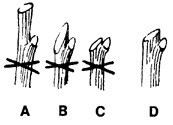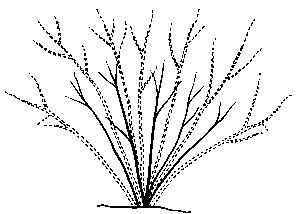Agdex No. 276.24
Pruning is the removal of selected living or dead parts of a plant to maintain appearance, health, and to regulate growth. It is used to increase flowering, rejuvenate, shape and improve structural strength of shrubs. There are no strict rules for pruning as each tree or shrub should be pruned to enhance its natural growth habit.
It is important to choose an appropriate shrub for each location. A shrub that is adapted to the soil type, amount of sun, and whose mature size fits the chosen spot will grow better and be more attractive. Also if the correct size plant is used, drastic pruning will not be required to keep a plant in its space in the future.
Thinning
Thinning is the removal of old, weak, diseased, or poorly placed branches (Figures 1 & 2). It preserves the natural appearance of the shrub and stimulates new growth. When thinning, the branch is cut off cleanly at its point of origin on the stem or at the base of the plant. Most shrubs do not require extensive thinning on a yearly basis.
Renewal Pruning
Renewal pruning is the removal in early spring of a few of the oldest, tallest branches of a shrub at or slightly above ground level. Old wood is then replaced with young healthy branches that will produce the maximum floral display.
Deciduous Shrubs
Deciduous shrubs fall naturally into two groups for pruning: shrubs that flower from early spring to early summer and shrubs that flower in late summer. The largest group is the early flowering shrubs which include forsythia, flowering almond, viburnum spp., Bridal wreath spirea, etc. These shrubs flower on the previous year's wood and therefore should be pruned or thinned after flowering. The flowers should be cut off just above the first pair of leaves before they produce seeds so the plant's energy is directed into new vegetative growth. If the shrub produces colourful fruit do not remove the flowers after bloom (i.e. shrub roses).
Shrubs that flower in late summer, flower on current year's wood and can be pruned in early spring before growth starts. Prune selectively to maintain the characteristic form of the shrub. Shrubs in this category include Hydrangea spp., Buddleia, witch hazel, potentilla, flowering currant, roses, etc.
Broadleaf Evergreen Shrubs
Broadleaf evergreen shrubs can be pruned in much the same way as deciduous shrubs. Pruning should be done in early spring before new growth starts.
Rhododendron spp. should be pruned for shape in the early spring but may require some pruning after flowering. After bloom the flowers should be removed and the vegetative buds pinched selectively to increase branching.
EVERGREEN SHRUBS
It is important when pruning any shrub to consider the natural growth habit before any cutting is done. Evergreen shrubs do not develop new growth from old wood so heavy pruning is not effective to rejuvenate these plants.
Cedar, yew, and juniper are shrubs that have an irregular branching habit. Fast growing branches can be pruned back to a healthy lateral from which new growth will occur. These trees respond well to shearing which is an overall trimming of a plant to cause dense growth and create a specific shape.
Juniper
In the spring vigorous growth of the horizontal forms of juniper can be cut back to a lateral branch and thus induce growth of lateral buds.
In the summer, about when the new growth has reached maximum extension around mid-July), it is time to shear upright junipers. Cutting back approximately 1/4 of the new growth is sufficient to create a denser tree.
Cedar and Yew
Cedar and Yew can be sheared at almost any time during the growing season but the best time is after growth has begun in spring. They are sheared in the same way as upright junipers.
Pruning Shape
In the Maritimes where there are heavy snow loads in the winter, evergreen trees and shrubs should be shaped with a narrower top than base. This also allows light penetration to the lower branches which is necessary to keep these branches healthy.


